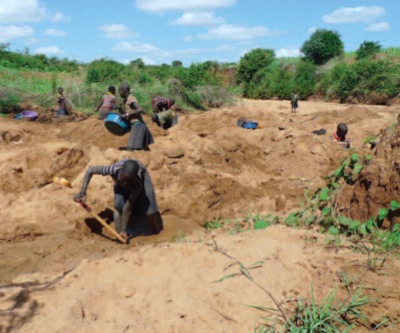
Uganda faces a tall order as it attempts to revamp its underperforming mining industry in the wake of slumping global commodity prices—the latest test to government’s efforts to rev up a faltering economy. In order to lure investors, government has proposed a wide range of tax breaks as well as scrapping of import duties on mining equipment ahead of the planned licensing round, according to Irene Muloni, the energy and mineral minister. Uganda hopes to lure investors by creating a more “favorable investment climate” with transparent allocation of licenses as well as the provision of up-to-date geophysical and geological data.
But freighted investors are cautiously watching, following months of back to back sliding commodity prices, over concerns of reducing demand in major economies—notably the U.S. and China.
Last year, Uganda completed a $75 million national mineral survey that identified occurrences of resources such as uranium, tin, coltan, nickel, copper and gold across the country. The survey, funded by the World Bank and Nordic Bank is intended to develop an advanced geological data to attract investors.
“Uganda’s mining industry, if well managed has the potential to transform this country and catapult it into the ranks of middle income nations sooner than later” said Don Binyina, the Executive Director for the Africa Centre for Energy and Minerals (ACEMP) “But infrastructure bottle necks, policy contradictions are key impediments to realizing this potential”
The World Bank survey divided Uganda into six blocks and found the western Uganda, which borders the mineral-rich but restive Eastern Congo to be the most endowed.
The country’ central region also holds huge potential as it’s an extension of the Green Stone Gold Belt in northwestern Tanzania, where Africa Barrick Gold and Anglo Gold Ashanti Ltd. (AU) already have large-scale gold mines according to analysts.
And government efforts are slowly paying off, according to industry officials. Chinese-owned Tibet Hima Industry Co., which was awarded a contract to develop Kilembe copper mines in 2013 is expected to resume operations after investing $175 million into the mine, believed to contain as much as 6 million metric tons of unexploited copper ores, according to company executivess.
The company plans to invest in smelting, refining and product factory development. Uganda’s mining industry, if well managed and monitored has the potential to increase its contribution to the country’s GDP as opposed to its current 0.4 % contribution.
But developments in Uganda come as the East African grapples with subdued prices. Although the global copper prices on the London Metal Exchange have staged partial recovery from a five-year low in recent weeks, the prices have lost more than 15% of their value since last year, amid concerns that the global economy may take longer than expected to return to full health.
One key concern was the World Bank’s forecast in January after the lender said that the global economy may expand by 3%, lower than the earlier expected 3.4%, citing economic turmoil in the eurozone and emerging markets.
Uganda’s mining sector currently accounts for less than 5% of Uganda’s export earnings compared to 30% in past years. Although contributing only 0.4% to GDP in 2012. Through the Uganda Chamber of Mines and Petroleum (UCMP), the private sector have consistently complained of value added tax (VAT) and withholding tax imposed during the investment phase of minerals labeling it an additional cost.
With the government firmly dedicated to use unexploited minerals to drive Uganda’s growth, the potential investor may feel safe the government is playing in the same team.
The commercial viability of some of the minerals has been established. But the greater chunk of the country is yet to be explored and viability needs to be established which calls for investment capital.
The mining sector in Uganda is a mixed breed between officially registered mining companies (both local and international) and artisanal and small-scale miners. Artisanal and small-scale mining (ASM) produces more than 90% of metallic, industrial and building minerals, providing livelihoods to almost 200,000 individuals. However, ASM is under regulated and hazardous, evidenced by the use of mercury in small-scale gold production.
The domination of the sector by artisanal miners is a major drag on the sector, rating agency Moody’s said this week. “The energy and mining sectors are attracting increased levels of Foreign Direct investments but the mining sector fluctuates with commodity prices” the agency said in a note Monday March 02
To spur the sector, Uganda is revamping infrastructure in the oil region. Rift Valley Railways is revamping the railway link to Kasese district ahead of the planned commencement of mining operations. A Chinese-funded multibillion-dollar standard gauge railway project in East Africa is also expected to boost trade in the region, according to the trade and commerce ministry.China Road and Bridge Construction Company (CRBC) started work on the first phase of the project in Kenya last month.
“Commodity markets are usually cyclic even with the current suppressed international metal prices, Uganda has chance to attract investors” said Mr. Binyina “But this can only be achieved if Uganda continues to align its mining policy and regulatory framework to international modern best practices and standards”.